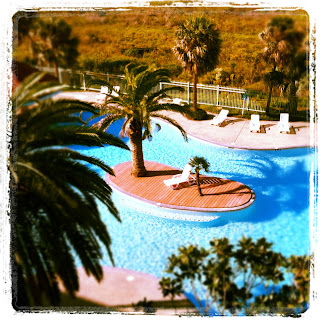Hey all!
With the Kemah Triathlon a week away (Yikes! Is it really?), I'm getting excited! I've done one before in October, but this one has a few extra twists than my last with alot more people and an open-water swim.
First off, what is a triathlon? It's simple... You swim a little, you bike a little and then you run a little. Think of it as a leisurely stroll through the park except you can drown, you can wreck on the bike, and you can run until your heart brakes. My previous philosophy on these three events was don't do them unless you are being chased, AND you know you can get away or else you'll get beat up tired. Not only are you not being chased, but you push yourself harder to beat other people! (What am I thinking?)
You have different distances in triathlons. Many of heard of the Ironman and Half-Ironman. These are long distance with the Ironman having a 2.4 mile swim, a 110 mile bike and 26.2 mile run. The Half-Ironman is just that, a quarter of an Ironman. (I hope you caught that, are you awake?). The Ironman distance started in Hawaii when swimmers and bikers on the island had a ongoing arguement on whose event was harder. So they combined them with a marathon and birthed the Iron distance races. These take alot of dedication and training with upwards of 15 hours a week of training. The next step is an Olympic distance with a mile swim, 24 mile bike, and a 6.2 mile run. For beginners and fast races there are the sprint triathlons with a 500 meter swim, 12 mile bike, and 3 mile run. This is what I am doing in Kemah.
 The Kemah Tri is open-water, which is harder than pool swimming because there are the elements to contend with. You have waves, wakes, currents, wind and pelicans trying to poop on you. I can handle most of these, but those pelicans make me mad. I did my first open water swim this week at Lake Benbrook in Fort Worth. It was difficult because you have to look out of the water and sight where you are going or you'll be off course. It is hard to stay level in the water with currents, waves, and wakes. Also, in the Great State of Texas the waters are usually murky and you can't see your hand in front of your face. This gave me some panic as I couldn't see what's in front of me, especially those Texas Lake Sharks. Pool swimming is great, but it doesn't get you ready for open-water.
The Kemah Tri is open-water, which is harder than pool swimming because there are the elements to contend with. You have waves, wakes, currents, wind and pelicans trying to poop on you. I can handle most of these, but those pelicans make me mad. I did my first open water swim this week at Lake Benbrook in Fort Worth. It was difficult because you have to look out of the water and sight where you are going or you'll be off course. It is hard to stay level in the water with currents, waves, and wakes. Also, in the Great State of Texas the waters are usually murky and you can't see your hand in front of your face. This gave me some panic as I couldn't see what's in front of me, especially those Texas Lake Sharks. Pool swimming is great, but it doesn't get you ready for open-water.
For open-water swims, you can usually wear a wetsuit like the studly man is above. This gives you floatation and a sleeker body line. For pool swims people will wear speedos, jammers (long speedos), or Tri suits. Tri suits are shirt and shorts that you are able to swim in, ride in and run in. They have some padding the butt area to help with the bike portion.
 |
| Here's my beauty. She doesn't have a name yet, but good ol' Marky Twain likes her. |
The run portion is just that, running. Running is the least favorite part of mine in the Tri. But the only equipment you need is a pair of shoes. That's easy. Check!
The last event in the Tri are the transitions. These are T1 and T2. With T1 being between the swim and bike and T2 being between the bike and run. Athletes will train on their transitions alone to reduce the amount of time they are not racing. This is wear a tri-suit comes in handy because you don't have to add or take away clothes, only your cycling shoes and running shoes. Elastic laces on shoes makes it faster by not having to sit down and tie your laces. Some will have their cycling shoes attached to the pedals, jump on after the swim and put their feet in the shoes as they race.
 |
| Pool @ the Condo. Ahhhh! |
After the Tri, I'll lounge at the pool in Galveston for a few hours and head back home with the family. I'll tell you all about it next week with plenty of photos!
Cheers,
Rob




